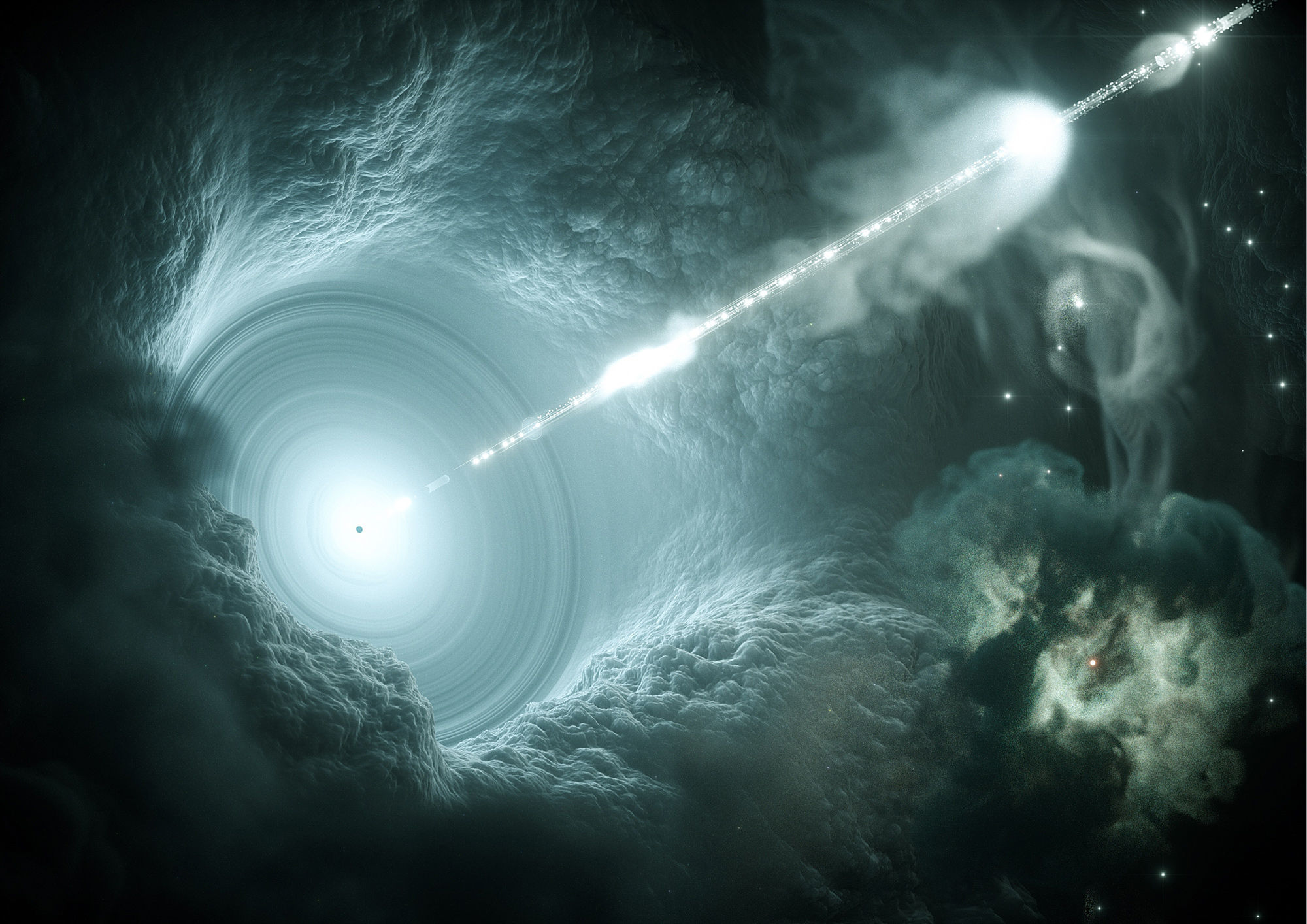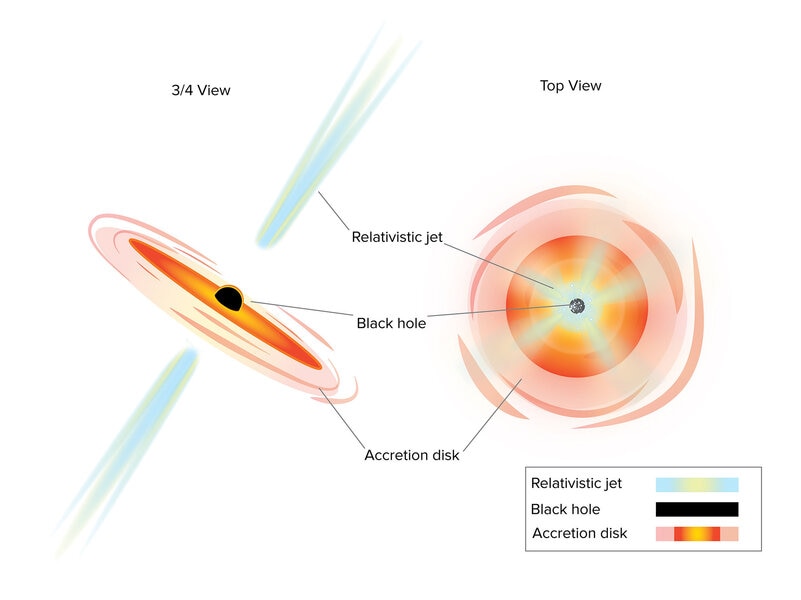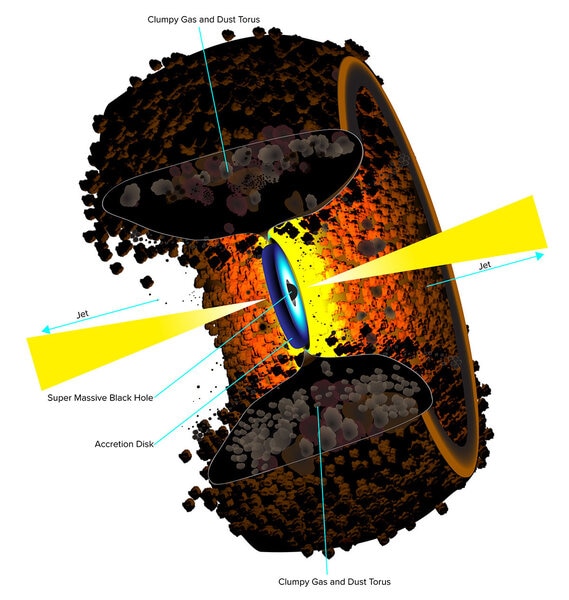Create a free profile to get unlimited access to exclusive videos, sweepstakes, and more!
Record-breaking blazar found 12.8 *billion* light years from Earth

Astronomers have found the most distant blazar yet seen, an active galaxy that was already blasting out staggering amounts of radiation when the Universe was less than a billion years old.
And I do mean staggering. In X-rays alone it's pouring out energy equivalent to over a trillion times the Sun's output over all wavelengths. This galaxy is a beast.
So what's this all about? We know that all big galaxies (and many smaller ones too) have a supermassive black hole in their centers. These black holes form extremely rapidly after the Universe itself did, and grow along with their host galaxies. Each affects the other in many complicated ways, with the growth of the black hole depending on gas and dust in the galaxy falling toward the center to feed it, for example.
On the other hand, as that material falls toward the black hole it piles up just outside the black hole's event horizon in a vast disk called an accretion disk. Friction heats it up, and it can become intensely hot, million of degrees hot. This heat can power winds of gas that blast away from the galactic center, pushing away gas farther out. That chokes off the black hole's fuel supply, which can shut the wind down. Like I said, it's complicated, and there are lots of feedback mechanisms.
In many cases this disk has an embedded magnetic field (as does the black hole itself). The rotation makes the magnetic field lines twist up into a vortex like a tornado, and these particles flow along these lines, spiraling up and away from the black hole. These can be highly focused, created what astronomers call jets screaming away from the galactic center. They can be incredibly tightly collimated, maintaining their beams for hundreds of thousands of light years before slowing down and puffing out to create what are called lobes on either side of the galaxy.
Galaxies like this are called AGN, for Active Galactic Nuclei. There are different kinds, depending on how we see them. From the side we see lots of radio emission from the lobes, and those are called radio lobe galaxies. If the jet is aimed more or less toward us we see even more powerful radio waves and higher-energy X-rays from them, and we call them quasars. If one of the jets is aimed almost or exactly at us, we see more X-rays and even gamma rays, the most energetic of all forms of light.
We call these galaxies blazars. They're relatively rare, because of the angle issue. They have to be aimed pretty much right at us, which is just luck of the draw. Most are not, and look like regular AGN.
Remember, every big galaxy, even our own, has one of these beasts. These days most are quiet, as the gas in many galaxies spends its time farther out from the center, so the black hole isn't fed. It's quiescent. But back in the day, when the Universe was young, gas flowed freely, and AGN were more common.
Remember, too, that light travels at a finite speed. When we see something really far away, that light left it when it was very young. The farther away we see an object, the younger we see it.
The new record breaking blazar is called PSO J030947.49+271757.31 (I'll call it J0309 for short). The astronomers who found it were looking for distant blazars; they examined archives of really big sky surveys across the electromagnetic spectrum, including the Very Large Array for radio, WISE for infrared, and Pan-STARRS for visible light. They searched nearly half the sky, a huge amount of real estate, for galaxies that were over 12 billion light years away. They found a half dozen, including J0309.
Using the huge Large Binocular Telescope they took spectra of the blazar and confirmed its vast distance. As the Universe expands more distant galaxies are swept away from us by higher and higher factors. This shifts the light they emit toward longer wavelengths, similar to a Doppler shift, what we generically call a redshift. If the galaxy is moving away from us so rapidly that all the wavelengths we see from it are doubled we say it has a redshift of 1 (due to the way the math is written out). If they're tripled it's at a redshift of 2, and so on.
J0309 is at a redshift of 6.1, a scalp-tinglingly high redshift. Depending on the cosmological factors you use, this puts it at a distance of 12.8 billion light years or so when the light we see left it. Mind you, the Universe is 13.8 billion years old, so this galaxy was already pouring out energy when it was less than billion years old. For comparison, the most distant blazar seen before it was at a redshift of 5.5, or roughly 12.7 billion light years.
One reason this is important is because these blazars are rare, they give us a handle on how many AGNs we should expect to see at the same distance. The astronomers calculate that one out of three active galaxies were blazars at that distance (or, if you please. at that time in the Universe's youth). Closer to home that ratio is lower, about 1 in 10, but the uncertainty in the more distant ratio is high. Essentially, those two numbers are consistent with each other. That means that by fraction of all AGNs, the Universe made as many blazars back then, more or less, as it does now. That tells us a lot about the way the Universe works!
So now the question is, are there more blazars at that distance? It's likely J0309 is the brightest, or else we'd have seen more earlier (that's always the case when looking for new kinds of objects or ones at great distances), but there could be more out there a bit fainter. The astronomers predict there could be 15–20 more out there, waiting somewhere in the sky to be found (perhaps by big 'scopes coming online soon, like the Vera Rubin Observatory). If so, this will tell us even more about what the Universe was like when it was extremely young, when galaxies were just forming and things were vastly different than they are today.
It makes me think of our own galaxy. No doubt the Milky Way was active back then, but how active? Were we a blazar to some galaxies now billions of light years away? I'm not sure we can ever know that, but it's interesting to ponder. And if so, I'm glad it settled down. A blazar is not a fun place to live, but an active nucleus was the past for most if not all galaxies, including our own.






























